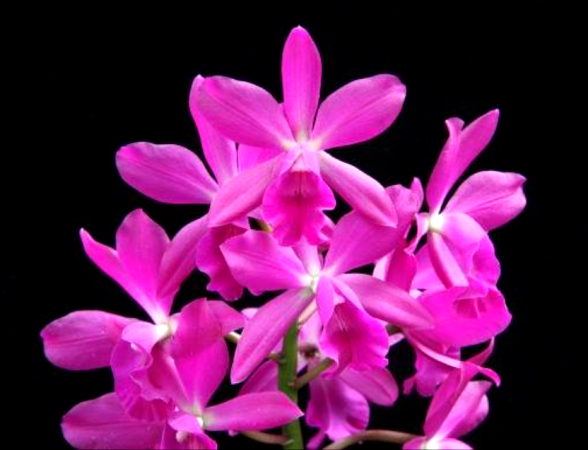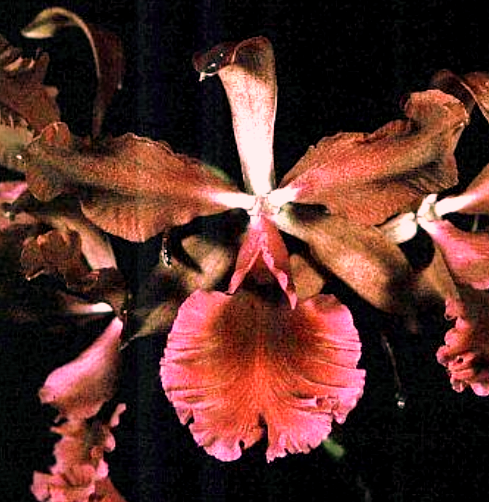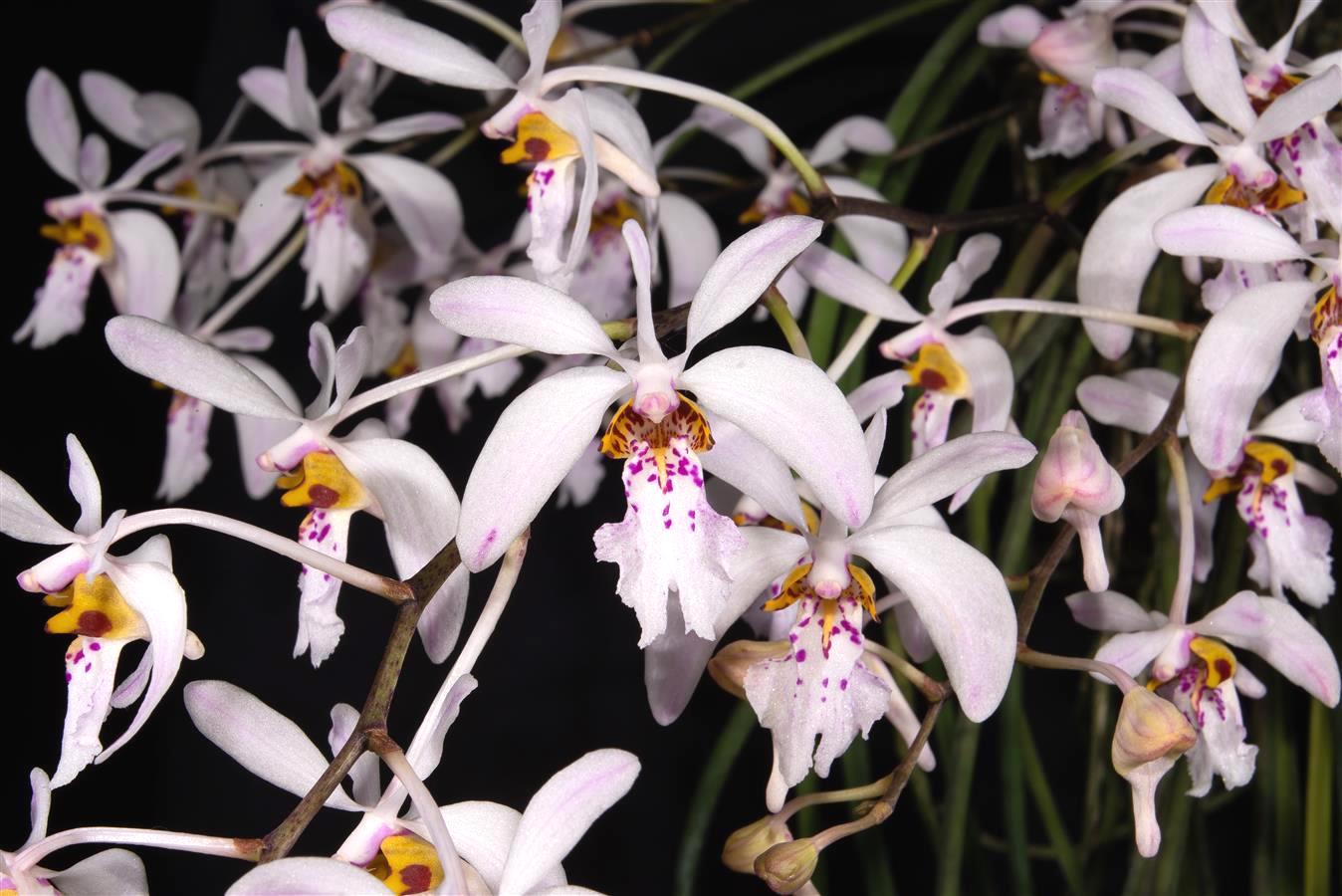
© 2018 Jason R. Mills
Holcoglossum wangii Rachel's Ice AM/AOS CCM/AOS, exhibited by Lynne Madonia November 19, 2018 at Atlanta Monthly Judging

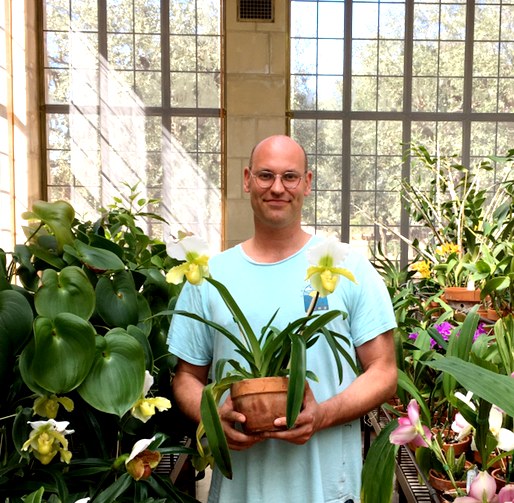
Tim is holding Paph. Yerba Buena 'White Caps' HCC/AOS, an exceptionally important cultivar in the development of modern green and white complex paphs. This cultivar was awarded in Oakland in 1967.
What makes a good program for an orchid society? Knowledge and enthusiasm, for starters! The speaker has to know the subject, of course, but it is also necessary to convey the excitement of these oddly enticing flowers, and to carry the audience along on a journey of discovery. Tim Culbertson definitely has the knack for teaching, whether for a big, formal lecture or for an impromptu conversation with a novice who wanders into our AOS judging center and is curious about some unusual plant. We always look forward to Tim's original and well-considered presentations. Here's what he has to say about himself and the program:

"Although I teach middle school kids for a living, one of my passions has always been plants. I began growing orchids as an offshoot from working at Longwood Gardens in Philadephia just after college. From the very beginning it was all about Paphs, particularly awarded and select clones of historic importance, of which my collection numbers nearly 3,000. While I love finding old, rare stepping stones in Paph breeding, I also do a little hybridizing of my own, and growing up my own babies is a blast. I am the youngest accredited judge with the American Orchid Society, and have served in various capacities with various orchid societies in California and on the East Coast. I love meeting other people who like orchids too, and doing so often finds me traveling to shows, vendors, and peoples’ greenhouses to see the latest and greatest in new hybrids and to get the best orchid gossip. I like to be involved in plants as much as possible: in addition to Longwood, I’ve worked at the Smithsonian Institution tending to their orchids, and for years for the United States National Arboretum, collecting rare plants and documenting cultivated species and hybrids for their herbarium. In short, I really like plants.
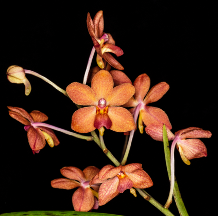
What sort of intergeneric Holcoglossum hybrid is this? Tim's program should enlighten us!
"For your meeting, I’ll be sharing a presentation on Holocoglossums: The Next Great Thing in Vandas. Holcoglossums are a relatively new genus to Vandaceous breeding, and they are already making a big splash: they are miniature, adaptable, and make great compact plants for windowsills or outdoors in Southern California. By combining Holcoglossums with basically every Vandaceous genus under the sun, we have been able to come up with some spectacular new combinations; in many cases, these are so new that they haven’t even been named yet! This is truly cutting-edge breeding, and you will be amongst the first to see and appreciate these new directions in miniature Vandaceous plants for outdoor or windowsill growing here. By the end of this presentation, you will have a new appreciation of the range of plant habits, floral forms, and colors of Holcoglossum species and hybrids, as well as an appreciation of their lovely flowers and ease-of-growth."
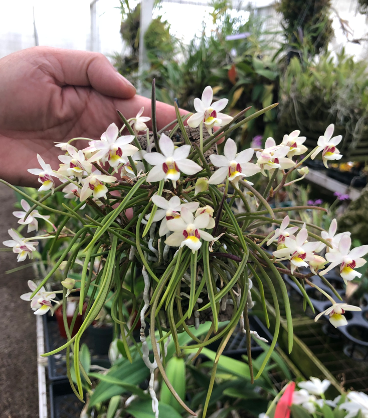
One of Tim's plants
AOS awards for Holcoglossum date back to 1969, but until quite recently, the handful of species were little known, regarded as "collector's items". There are now about a dozen species (although, as is the case for almost any group of orchids these days, the situation has been complicated by some difficulties with nomenclature), and some impressive specimen plants have turned up at the judging tables. The latest Wikipedia page for Holcoglossum lists ten intergeneric names involving this genus, but we haven't actually seen even one of them!
Two new species were described by Eric A. Christenson (Lindleyana 13(2):121-124 (June, 1998), Two new species of Holcoglossum Schltr. (Orchidaceae: Aeridinae) from China) from plants imported into the US from Yunan, China. The plants were originally labeled as species quasipinifolio (otherwise known only from Taiwan) and junceum, a synonym of a species more commonly known as Ascocentrum himalaicum. As a result of Christenson's study, the two forms are now known as Holcoglossum species tangii and wangii. The latter has several awards already. Some local growers have had good success with various Holcoglossum species growing outdoors on cork or wood mounts.
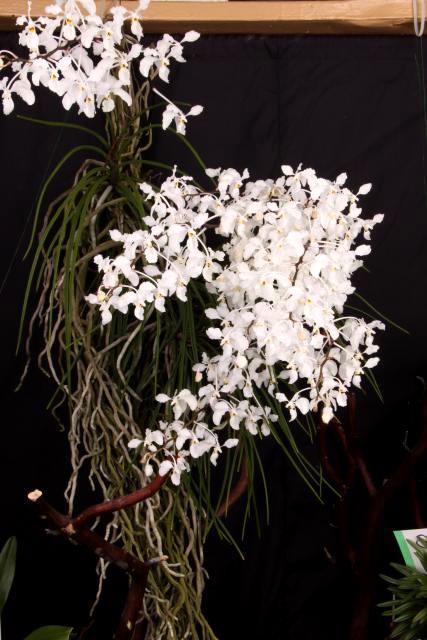
© 2011 Arthur Pinkers
Holcoglossum subulifolium 'Sycamore Creek' CCM/AOS, exhibited by Bill Robson at the Santa Barbara International Orchid Show, March 10, 2011

© 2017 Arthur Pinkers
Holcoglossum Pink Jenny 'Profusion' HCC/AOS, exhibited by Peter Lin at Pacific South Monthly Judging, December 9, 2017
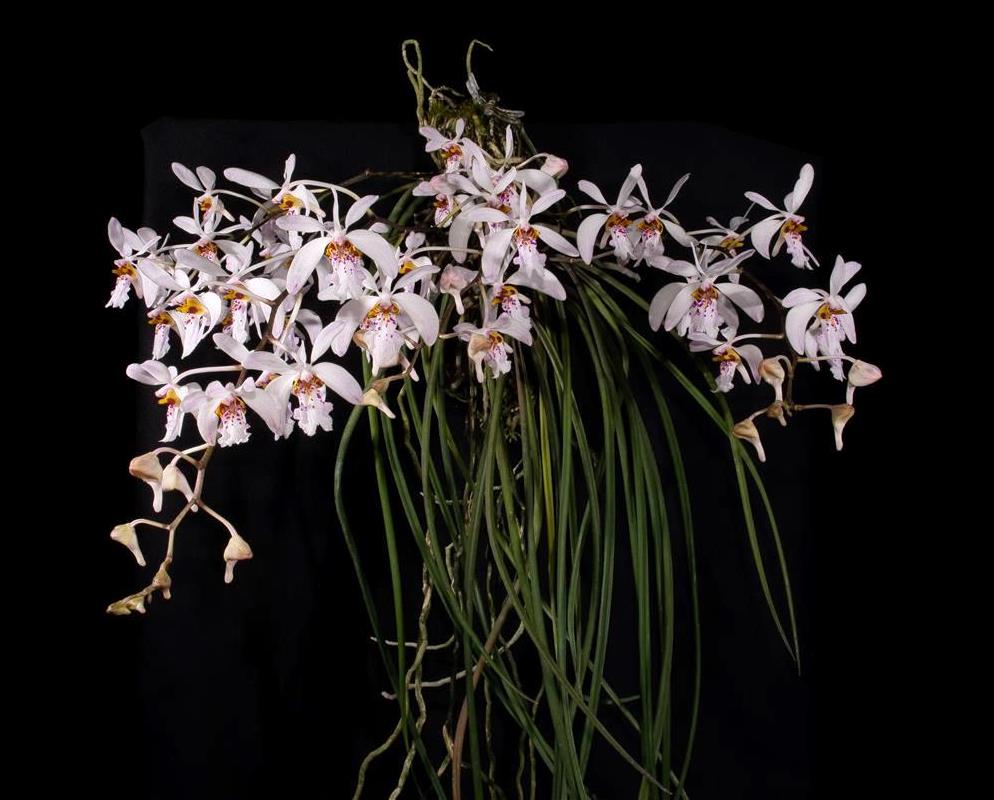
© 2018 Jason R. Mills
Holcoglossum wangii 'Rachel's Ice' AM/AOS CCM/AOS, exhibited by Lynne Madonia at Atlanta Center Monthly Judging, November 10, 2018
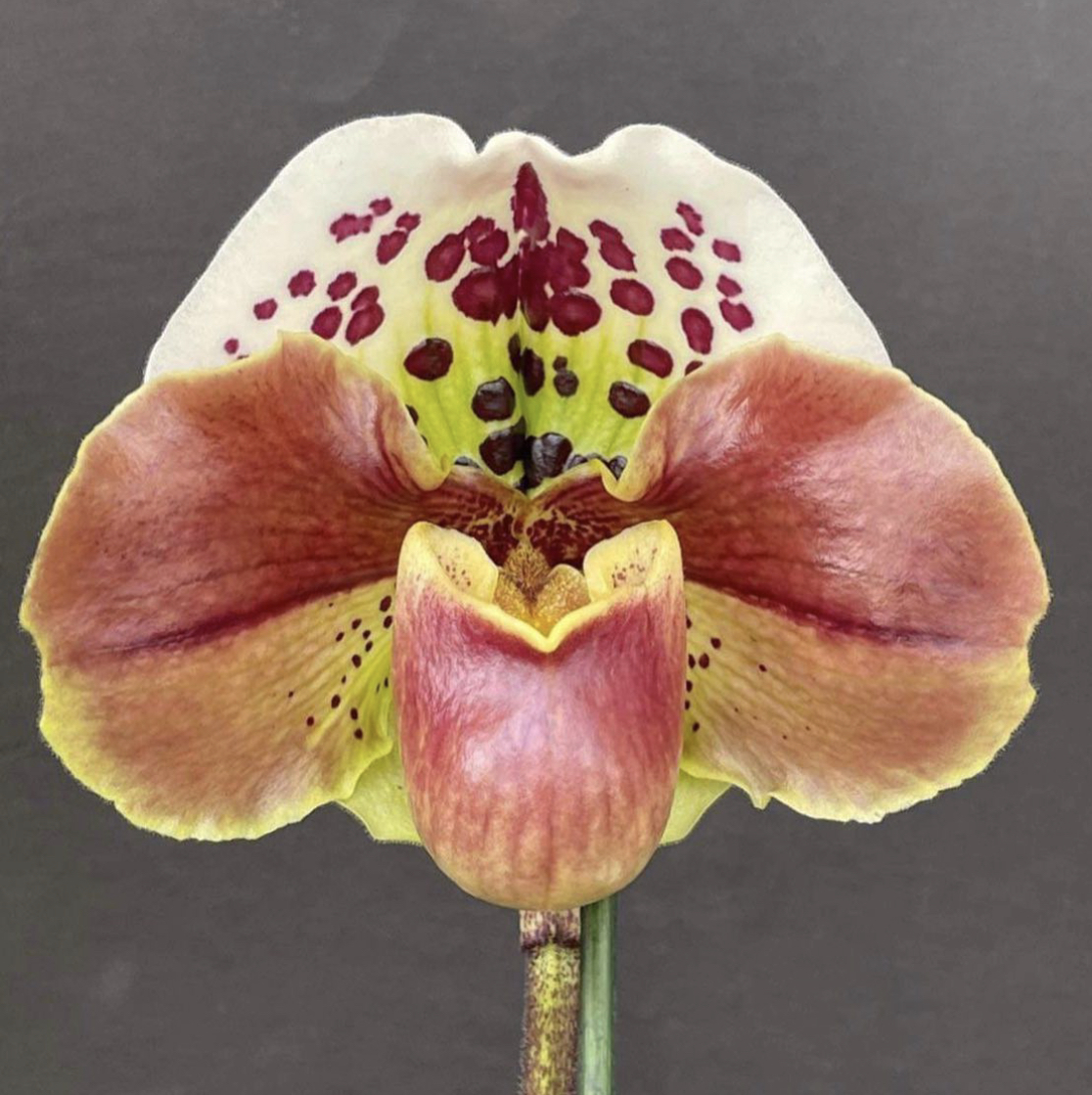
Paphiopedilum British Bulldog, a descendant of the famous Paph. Winston Churchill 'Indomitable' FCC/AOS, originally produced by Stuart Low Nursery in England in the mid 1940's, and exported from England as a seedling.
For our May 23, 2022 meeting, not long after we emerged from the pandemic shutdown, Tim presented a sort of botanical marathon, a presentation entitled “Historic Paphs: Passions and Paradigms of 150 Years”. Tim told us, "One of my absolute favorite parts about collecting orchids is thinking about their history, and Paphs have an especially rich history. I will share some of the important cultivars still in existence, and stories of their owners, breeders, and movements from one nursery to the next. These stories shed a new light on how we have gotten where we are; they provide a background for modern plants and why they are so important and so special. Southern California has an important role in these stories! By the end of this presentation, you will have a new appreciation of the history of important nurseries and collectors and collections, as well as breeding trends for these types of plants, and an appreciation of their beautiful flowers."
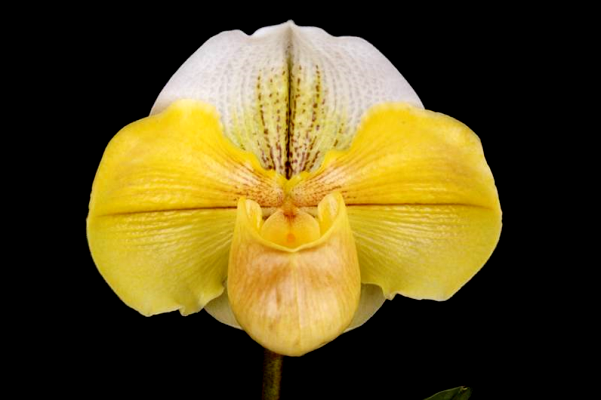
© 2015 Arthur Pinkers
Paphiopedilum Stone Crazy 'Beauty' HCC/AOS, one of Tim's plants awarded at our AOS Judging Center on February 23, 2015
He wasn't kidding! The accomplishments of generations of Paph breeders turned out to be astounding. The early crosses were made under conditions where the growers were lucky to obtain even a few viable seedlings from a cross, yet they persevered, planning their strategy carefully and seeking out the best available flowers for the next cross. Plants found their way all over the world, even though Paphs, with few exceptions, are almost always propagated only by divisions or from seed. So careful were the growers over more than a century, that a number of the original cultivars still exist and are even "widely distributed". Kudos to Tim for putting together this ambitious program, and especially for tracking down photos of almost every plant mentioned!
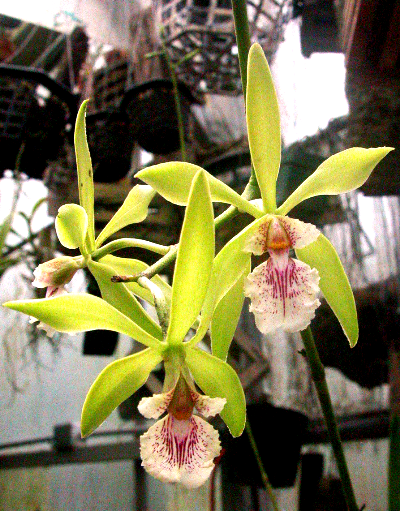
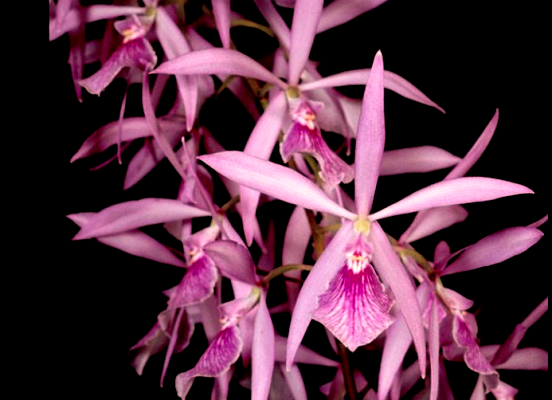
For our May, 2019 meeting, Tim tackled the group of New World orchids known as Encyclia, from "Mexico and Beyond". These spectacular Cattleya relatives grow well outside in Southern California, and with their compact habit, great fragrance, and ease of growth, these are delightful plants for every collection. By extending the traditional definition of Encyclias to include recently-separated groups like Anacheilum, Panarica, Prosthechea, Euchile, and others that Tim says he and many others grew up calling Encyclia (maybe that's how Tim first knew them, but some of us at South Coast Orchid Society go back far enough that we still think of them as Epidendrum! — And now, a BIG THANK YOU to the taxonomists for giving us so many possible names, each more difficult to spell than the last ones they proposed, for these otherwise delightful plants), we end up with a diverse, beautiful, fragrant, exciting group of plants and flowers; if we add those to the wonderful flora of Mexico and Central America, we have a group that every collector should grow. What an enjoyable program!
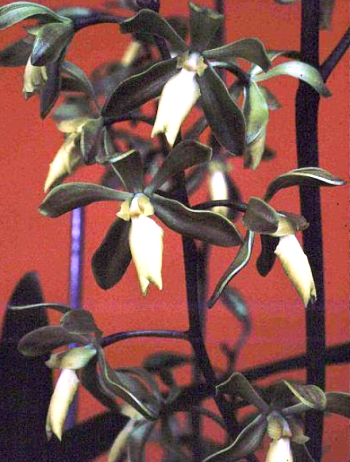
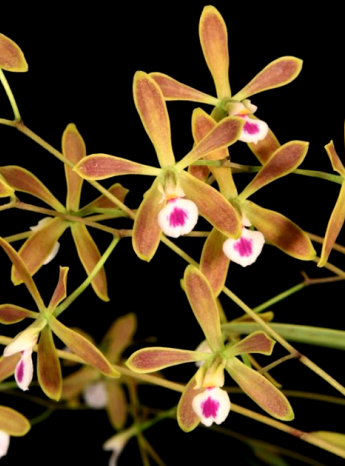
Quite a few Encyclia and related species have been used in hybridization, but it seems to us that their potential is only beginning to be appreciated. Relatively few of the registered hybrids have found a wide following in the trade or on judging tables. One recent exception is the interesting hybrid Guaricyclia Kyoguchi (Guarianthe [=Cattleya] aurantiaca x Encyclia incumbens [=aromatica]), which produces clouds of bright yellow flowers with a pretty lip, and a few clones with semi-alba flowers. This hybrid is now turning up as seedlings (sibling crosses from selected cultivars) and also as a parent in new hybrids at Sunset Valley Orchids.
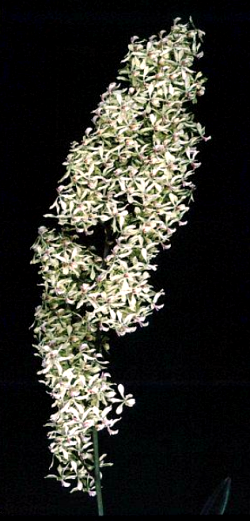
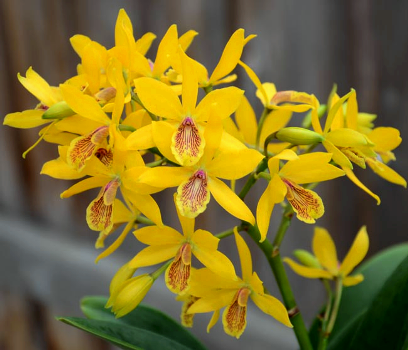
Another strategy is to cross interesting Encyclias with large or floriferous Cattleyas. Two impressive examples are shown here, Guaricyclia Voila (Guarianthe bowringiana x Encyclia cordigera) and Catyclia Florida (Cattleya dowiana x Encyclia cordigera).
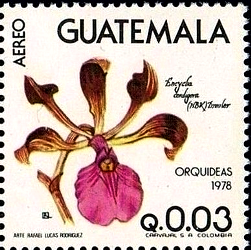
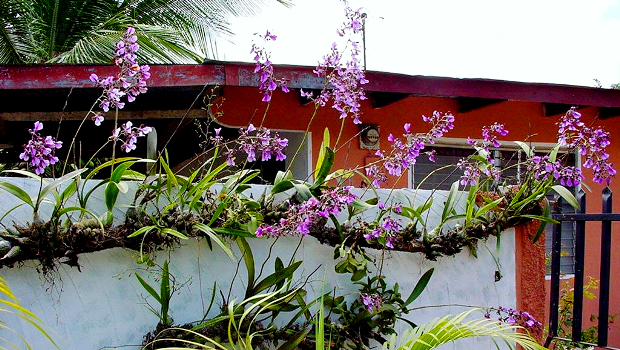
There is a lot of natural variation in many of the Encyclia species: alba varieties, variations in the size and color of the lip, varieties with much darker petals, etc. There are also Encyclias (and varieties) with many different fragrances, such as raspberry or chocolate. Watch for new hybrids!
